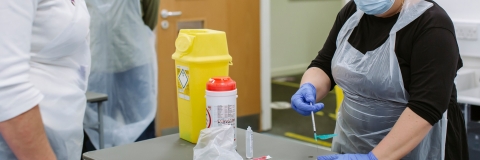

Sharps
Safely dealing with a sharps injury.
Introduction
Sharps are defined as any tool that is contaminated and can puncture the skin. Examples of sharps used in laboratories include scalpels, blades, needles and broken glass.
Injuries involving sharps can be very serious, as the contaminated tool can introduce hazardous material such as chemical and biological agents directly into the body. Sharps that can contaminated with tissue, blood or body fluids from an infected source can also cause a serious risk of blood borne viruses (BBVs).
Sharps injuries are not only a risk to those working with the contaminated tools, but also to anyone else if they have not been correctly disposed of.
For More Information
| Elimination | Do not use sharps if there is no need to. |
| Substitution | Substitution for a less hazardous sharp or no sharp at all. For example, wide bore needle or cannula instead of a hypodermic needle, using a pipette instead of a needle, and plastic alternatives to glass where possible. |
| Engineering controls | Use of safer sharps devices. These are devices that have features to prevent or minimise accidental injury. |
| Safe System of Work |
NEVER re-sheath a needle
NEVER remove the needle from a syringe
NEVER carry sharps around by hand. Use a tray or container
NEVER put sharps in the laboratory coat pocket
NEVER dispose of sharps in domestic waste
NEVER retrieve items from sharps waste
ALWAYS report accidents or near misses to H&S and use the correct tool for the job
ALWAYS point sharps away from you and others
ALWAYS dispose of correctly in a sharps box
ALWAYS use single-use blades where possible
ALWAYS ensure that anyone using sharps has had training and is competent (Training should include working with sharps and also associated procedures for example accident reporting and waste procedures)
ALWAYS discard cracked or chipped glassware |
| Personal protective equipment |
PPE must be worn when handling human blood, tissue and body fluids
Exposed cuts and broken skin must be covered by waterproof dressing.
Wearing gloves to protect from sharps injuries can be worn, however, it is important to consideration the loss of dexterity or ability to handle equipment |
When disposing of sharps correctly, consider the following points:
- Sharps must only be disposed of in approved bins (BS EN ISO 23907:2012)
- Bins must only be filled up to the fill line
- The waste must never be pushed down inside the bin
- Bins must be placed on the bench, not on the floor or at height
- When not in use, bins should be temporarily closed
- Nothing other than sharps should be placed in dedicated sharps bins
- Once full, bins should be stored in a dedicated place whilst awaiting collection
- Unless small enough to do so, glass should have a dedicated waste stream. It must not be broken further in order for it to fit in the sharps bin
For more information on what actions to take in the event of an incident involving sharps, please refer to the First Aid Arrangement:

